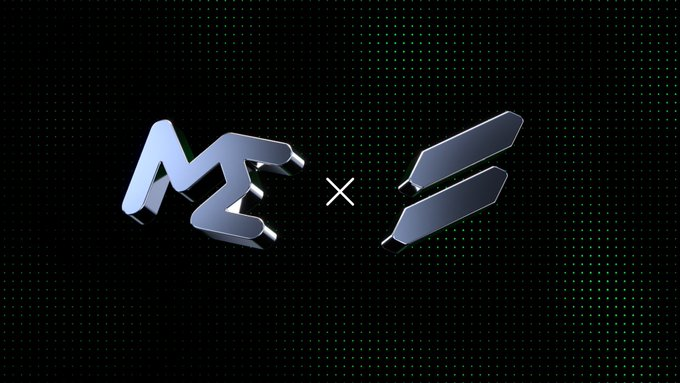Acquisition Background: A Strategic Breakthrough Amid a Sluggish NFT Market
On April 10, 2025, the NFT trading platform Magic Eden officially announced the completion of its acquisition of the decentralized trading application Slingshot. This deal marks the first deep integration of NFT and DeFi infrastructure in the Web3 industry. As the leading NFT market within the Solana ecosystem, Magic Eden has faced the challenge of a continuously declining trading volume in recent years.
Data shows that in Q1 2025, its NFT sales declined to only US$1.6 billion, a decrease of 82% compared to US$8.9 billion in 2024. Meanwhile, Slingshot, leveraging its “bridge-less cross-chain trading” technology, supports users in trading more than 50,000 assets across 10 chains (including Ethereum, Solana, and Polygon) using a single USDC balance, achieving an average daily trading volume of US$230 million, and emerging as a dark horse in the decentralized trading arena.

The primary goal of this acquisition is to break through the growth bottleneck in the NFT market. Magic Eden plans to combine Slingshot’s cross-chain trading capabilities with its NFT platform to create a comprehensive trading ecosystem covering assets across all chains (including an upcoming Bitcoin chain support). For example, in the future users will be able to trade NFTs and tokens directly through the Magic Eden wallet without switching platforms while enjoying transaction costs as low as US$0.001.
Technical Integration: Three Breakthroughs in Cross-Chain Interoperability
Unified Accounts and Liquidity Sharing
Slingshot’s “on-chain abstraction” technology allows users to manage multi-chain assets with a single wallet, eliminating the complex process of traditional cross-chain bridges. Magic Eden will integrate this functionality so that NFT collections and token trading share one account system. For example, an NFT purchased on the Solana chain can be directly used as collateral to borrow stablecoins on the Ethereum chain.
NFT and DeFi Liquidity Fusion
Through smart contract connectivity, Magic Eden plans to bridge the NFT liquidity pool with Slingshot’s token liquidity pool. Users may fractionalize their NFTs and inject them into DeFi protocols, or stake NFTs to earn governance token rewards. This model has already been verified in projects like Azuki, where NFT holders share 20% of the platform’s revenue.
Expansion of the Bitcoin Ecosystem
Magic Eden announced that it will support on-chain asset trading for Bitcoin by 2025, utilizing Slingshot’s cross-chain bridge technology to enable the exchange between Ordinals inscriptions and ERC-20 tokens. This move is expected to attract Bitcoin holders to the NFT market, with an anticipated increase of over 5 million new users.
Economic Model: Balancing Token Burn and Revenue Sharing
To increase the token’s value, Magic Eden has launched a dual-track economic mechanism:
-
Token Burn:20% of all transaction revenue is used to buy back and burn the native platform token ME. Based on an annual revenue of US$75 million in 2024, this is expected to reduce the circulating supply by approximately 150 million tokens per year.
-
Revenue Sharing:Slingshot users can earn an annual yield of 8%–12% by staking tokens, with a portion of the revenue distributed to NFT creators and node operators, forming a sustainable incentive loop.
Industry Impact and Potential Challenges
Reshaping the NFT Trading Paradigm
Cross-chain liquidity sharing may give rise to new trading scenarios, such as NFT collateralized lending, fractionalized trading, and cross-chain copyright licensing. For example, virtual landowners in Decentraland could divide their parcels into tokens and sell them on the Polygon chain.
Accelerated Adoption of Layer2
Slingshot’s low Gas fee model (for instance, on the Polygon chain, transaction costs are below US$0.001) is expected to drive more users from the Ethereum mainnet to Layer2 solutions, with projections that Layer2 trading volume will exceed 45% of total volume by 2026.
Security and Regulatory Risks
Cross-chain bridges have repeatedly been targets of hacker attacks (as seen in the Poly Network incident), so Magic Eden must strengthen smart contract audits and verification mechanisms. Moreover, if the U.S. SEC classifies cross-chain trading as a securities activity, it may restrict the revenue-sharing model.
Future Outlook: From Trading Platform to Web3 Gateway
According to its roadmap, Magic Eden plans to launch a multi-chain wallet integrated with a fiat gateway in 2026, and to collaborate with Visa and Shopify to support merchant crypto settlements. If this strategy succeeds, Magic Eden could become the core hub connecting traditional finance with the Web3 ecosystem.
For users, the ultimate value of cross-chain technology lies in “frictionless switching.” As stated by Magic Eden CEO Jack Lu, “The future Web3 experience should enable users to focus on value creation, not be bogged down by the choice of underlying blockchains.”





